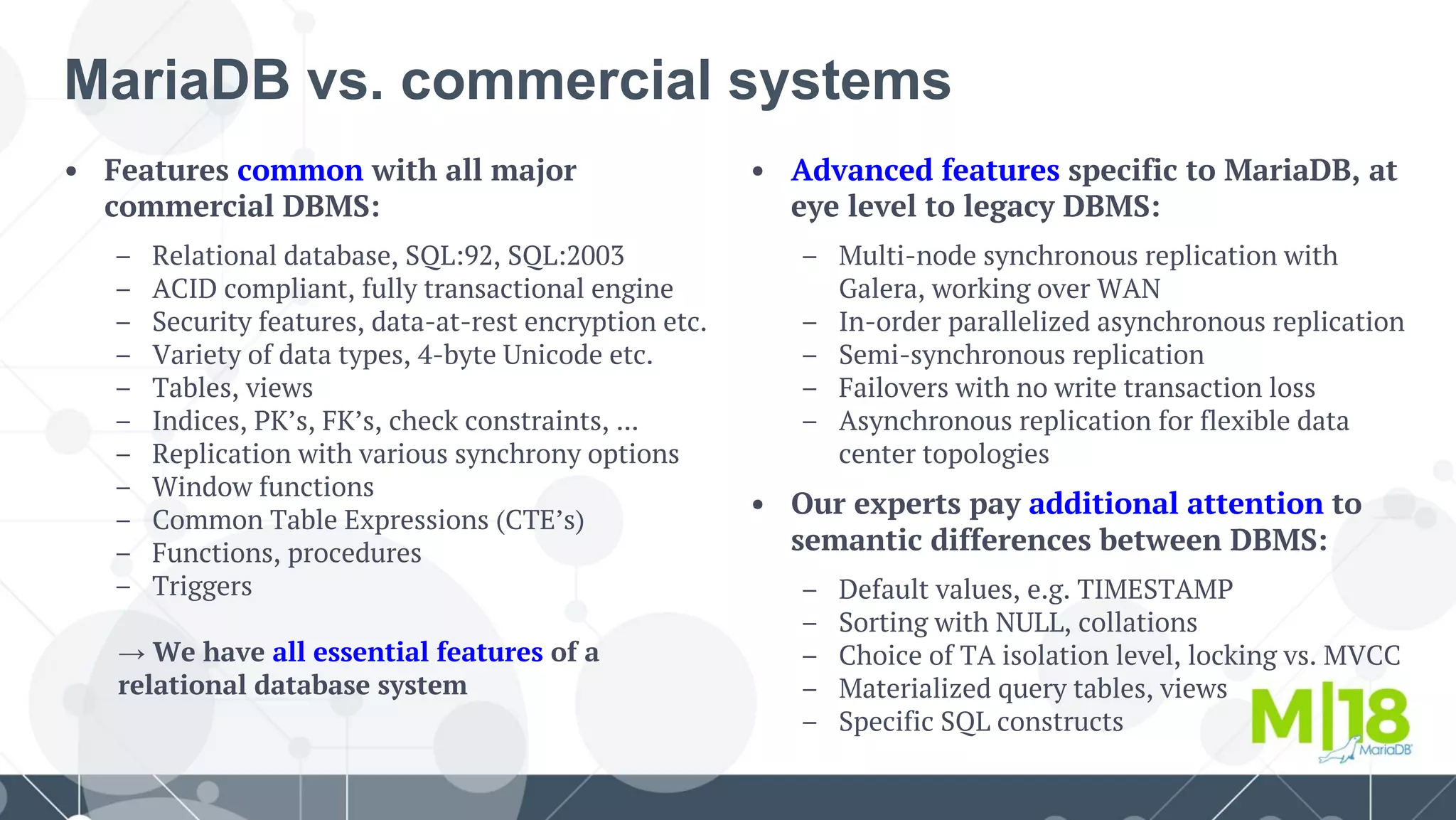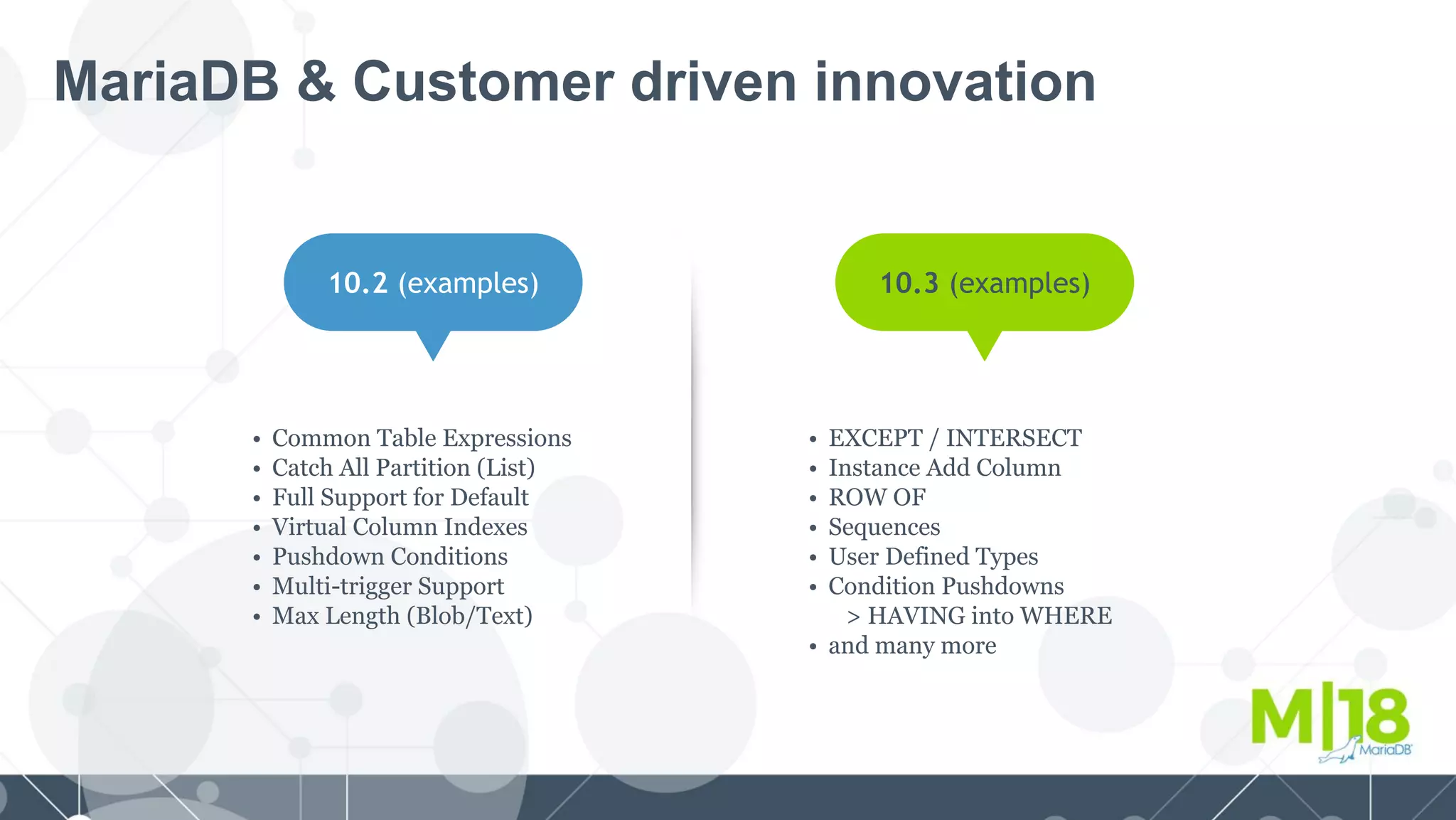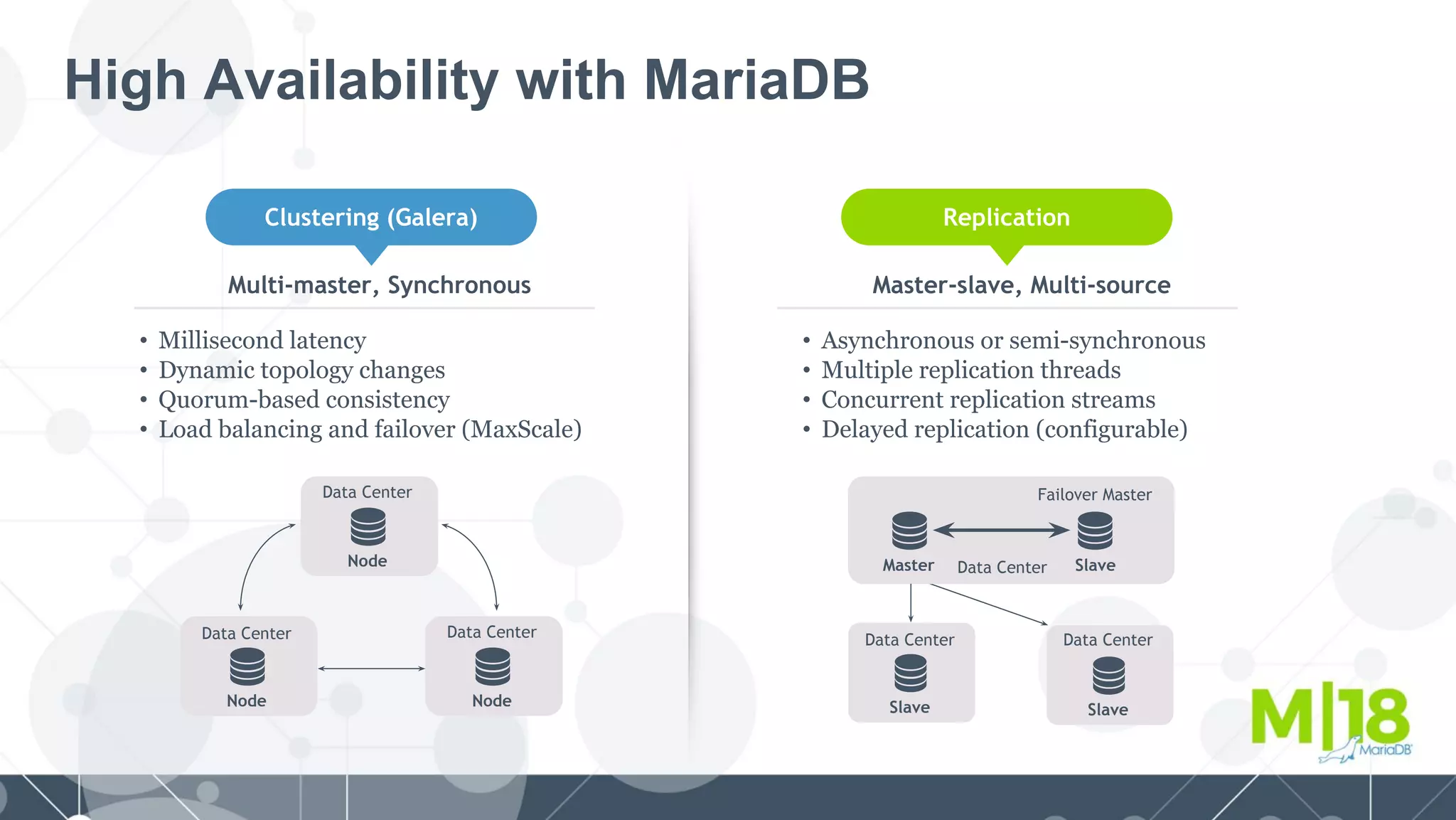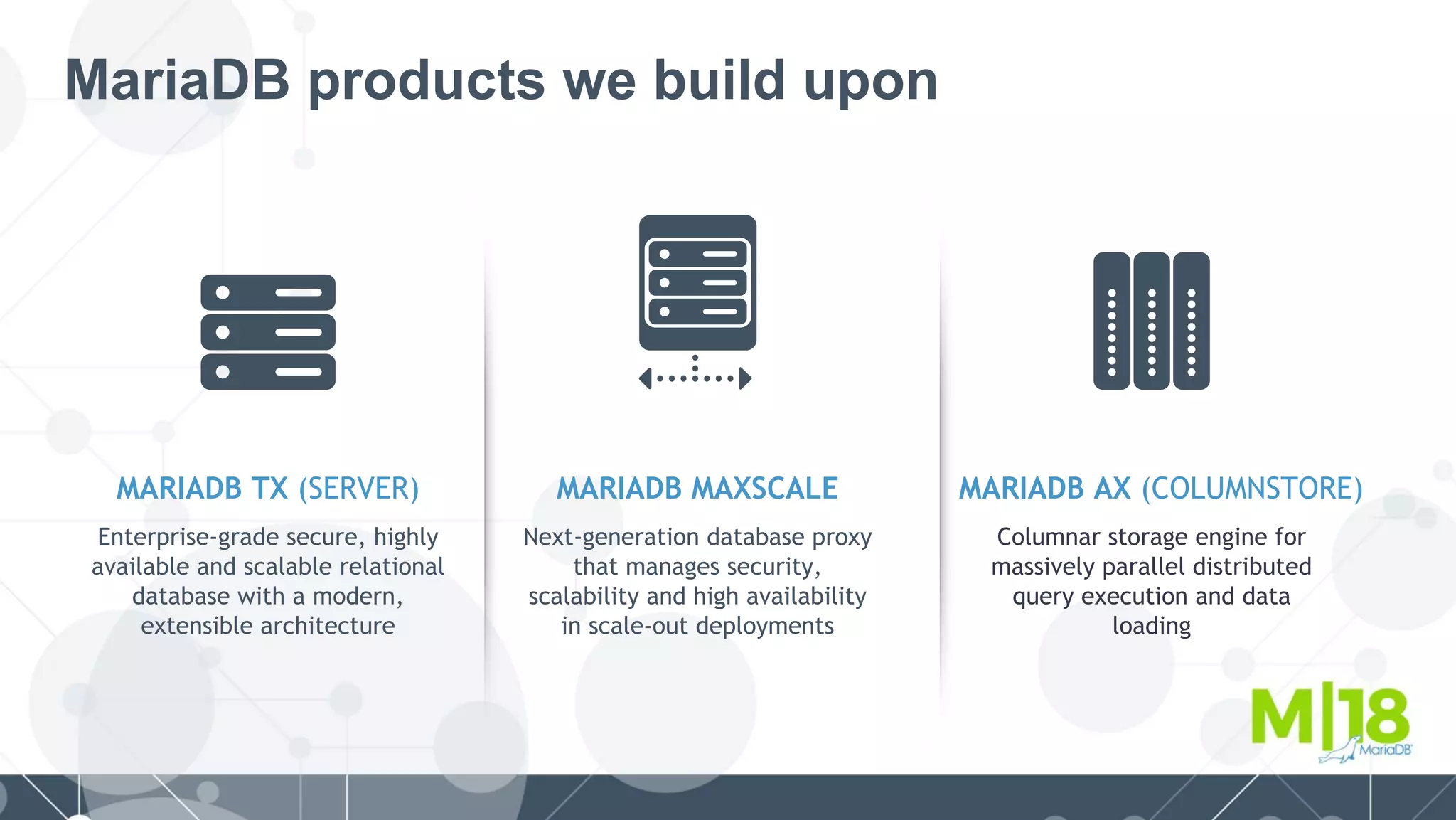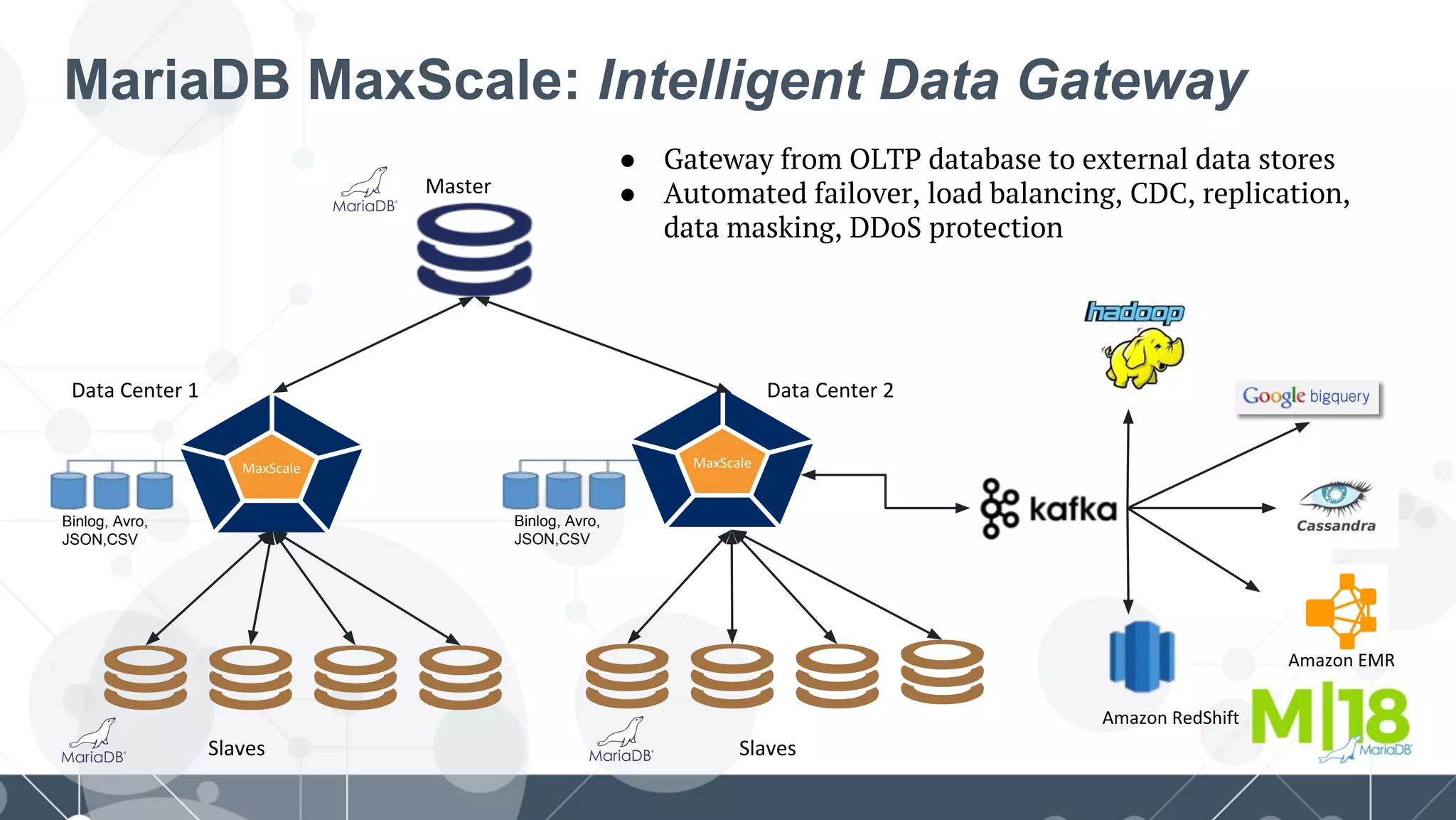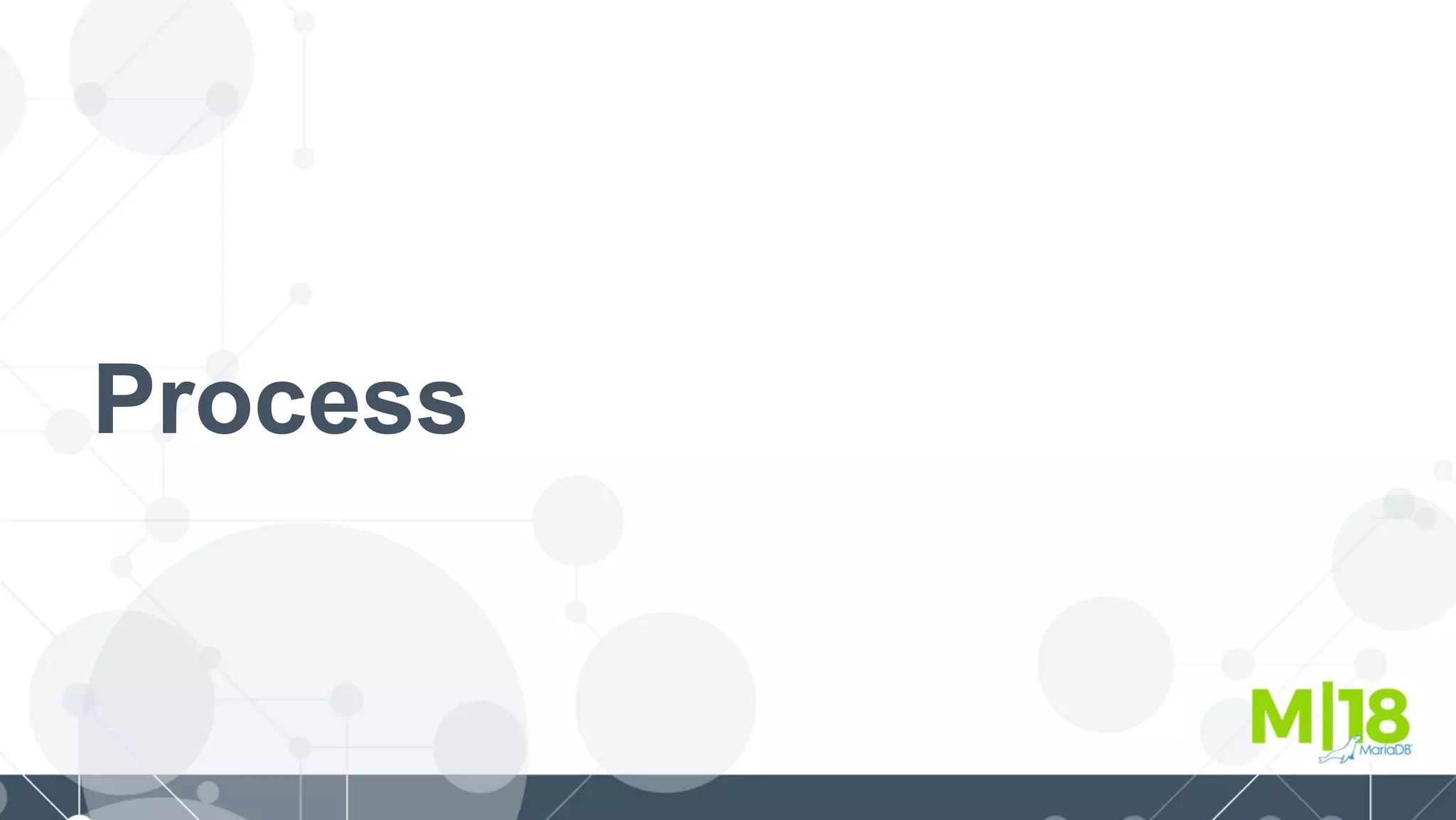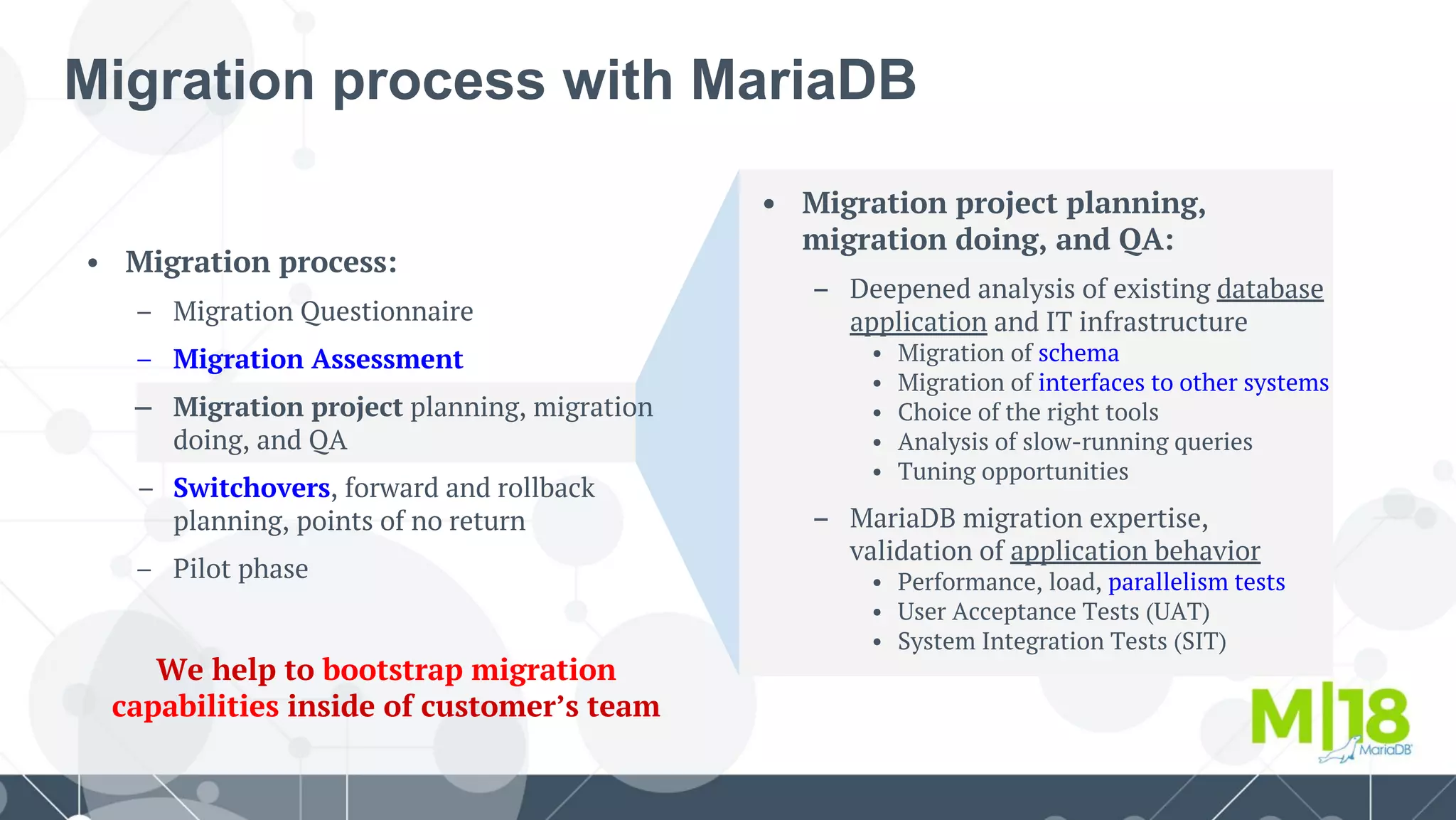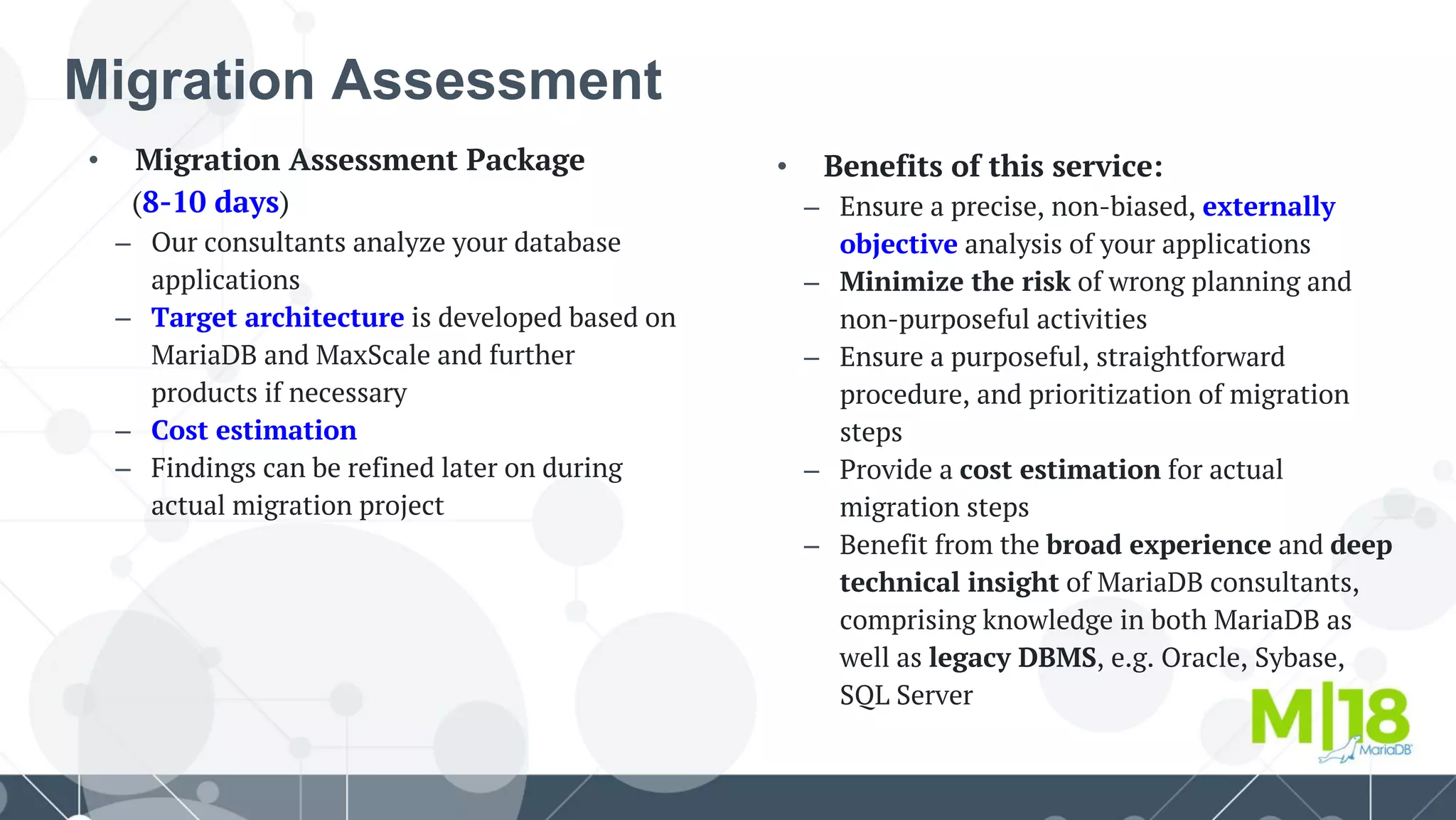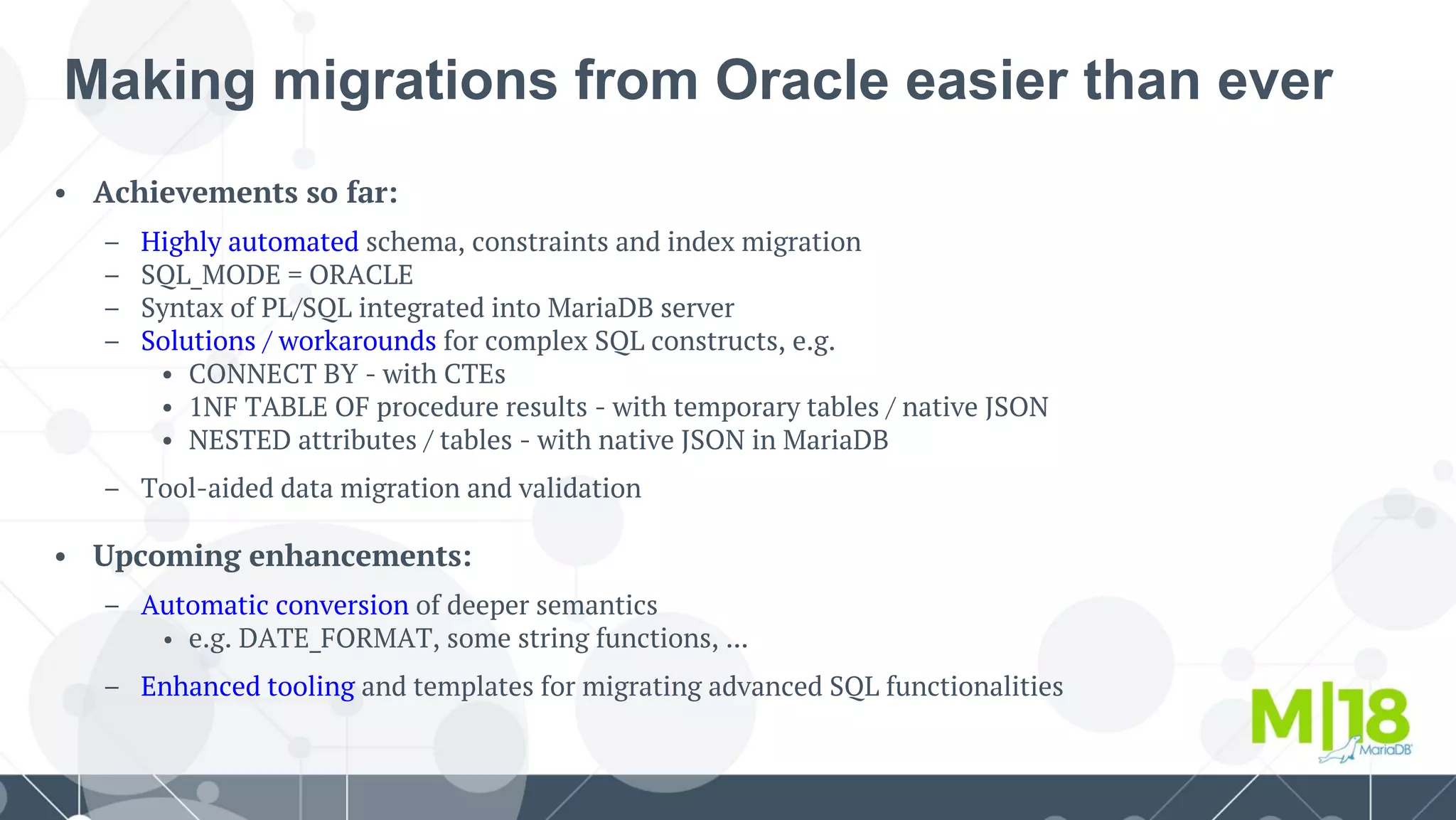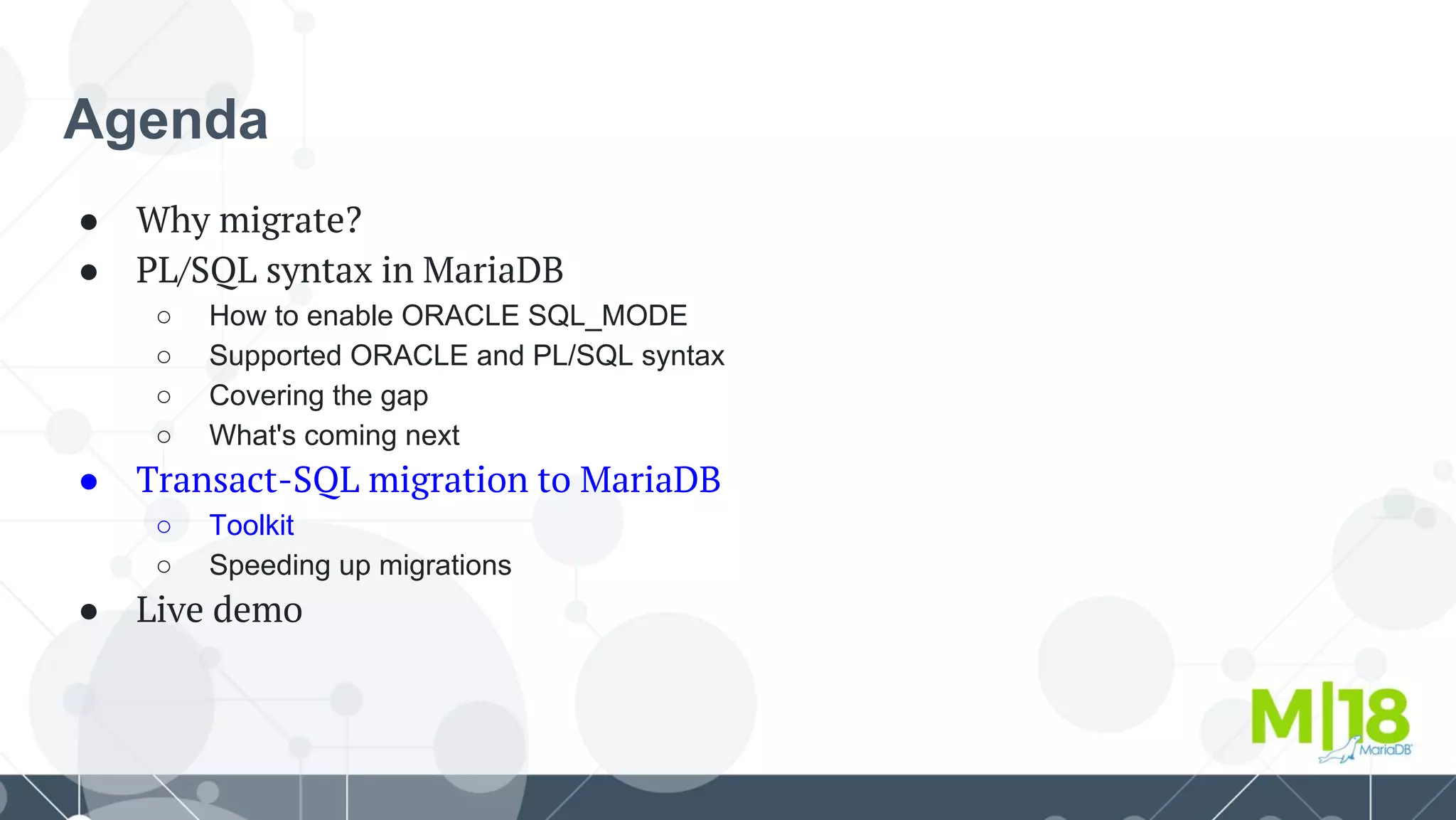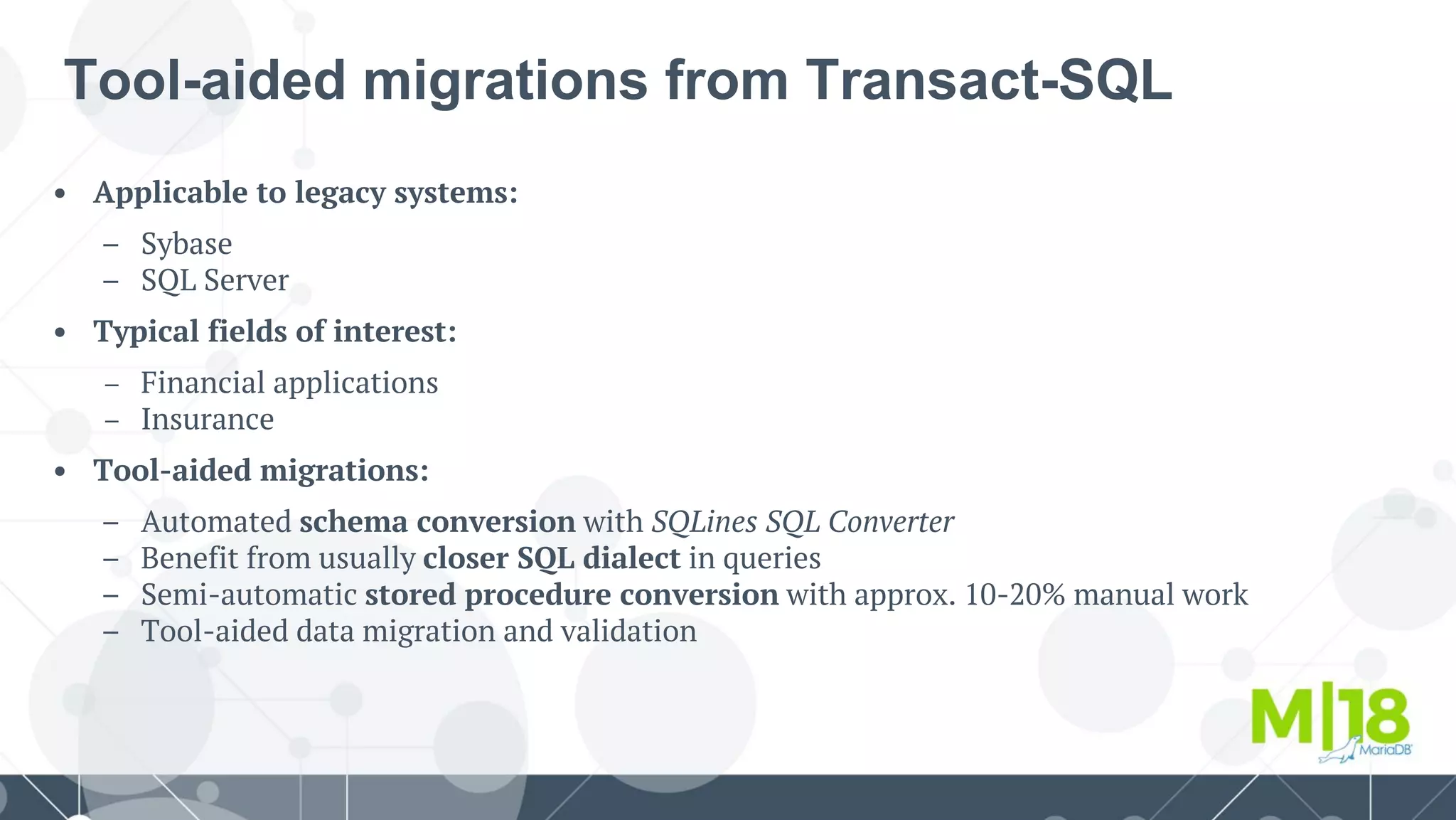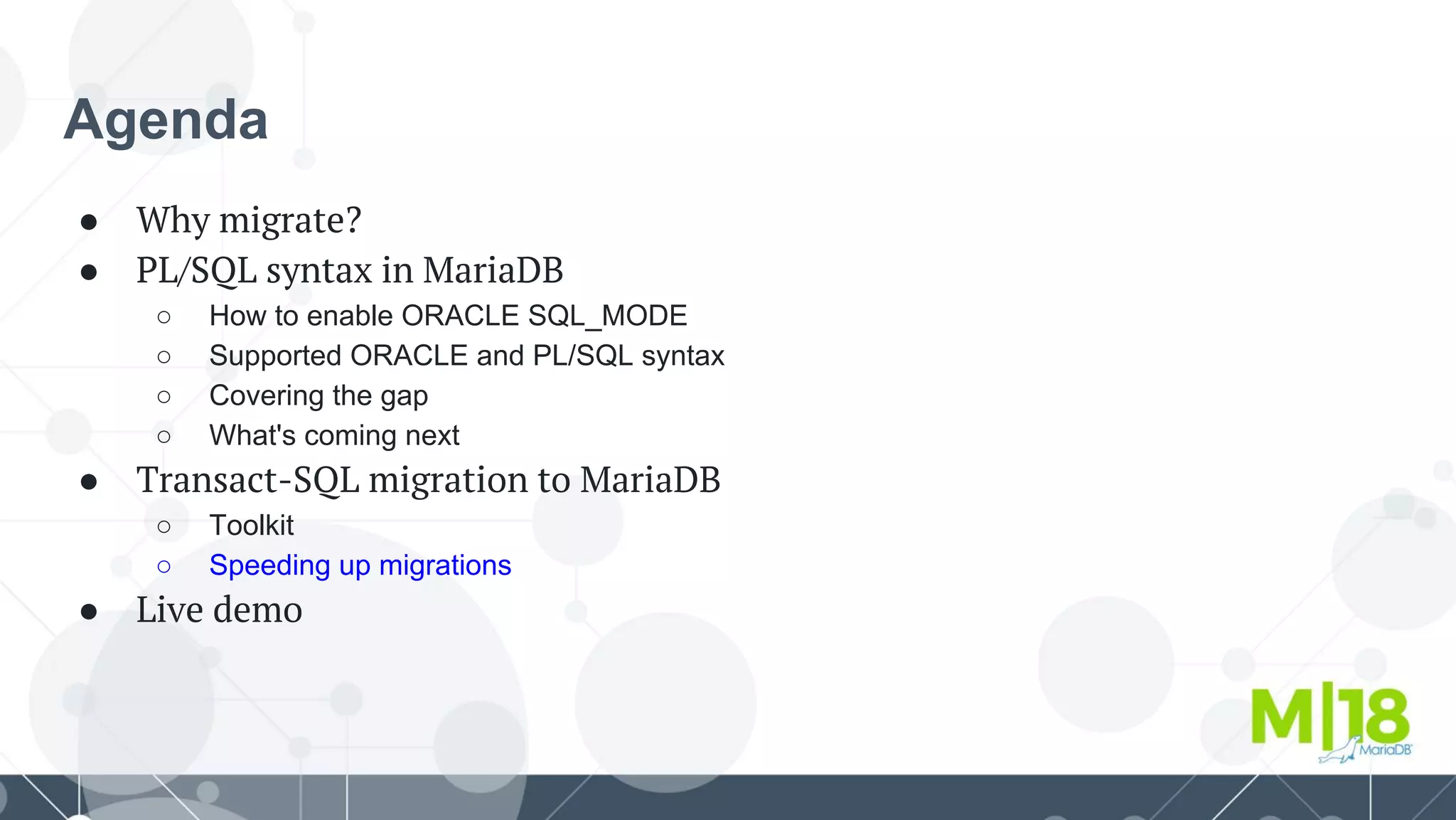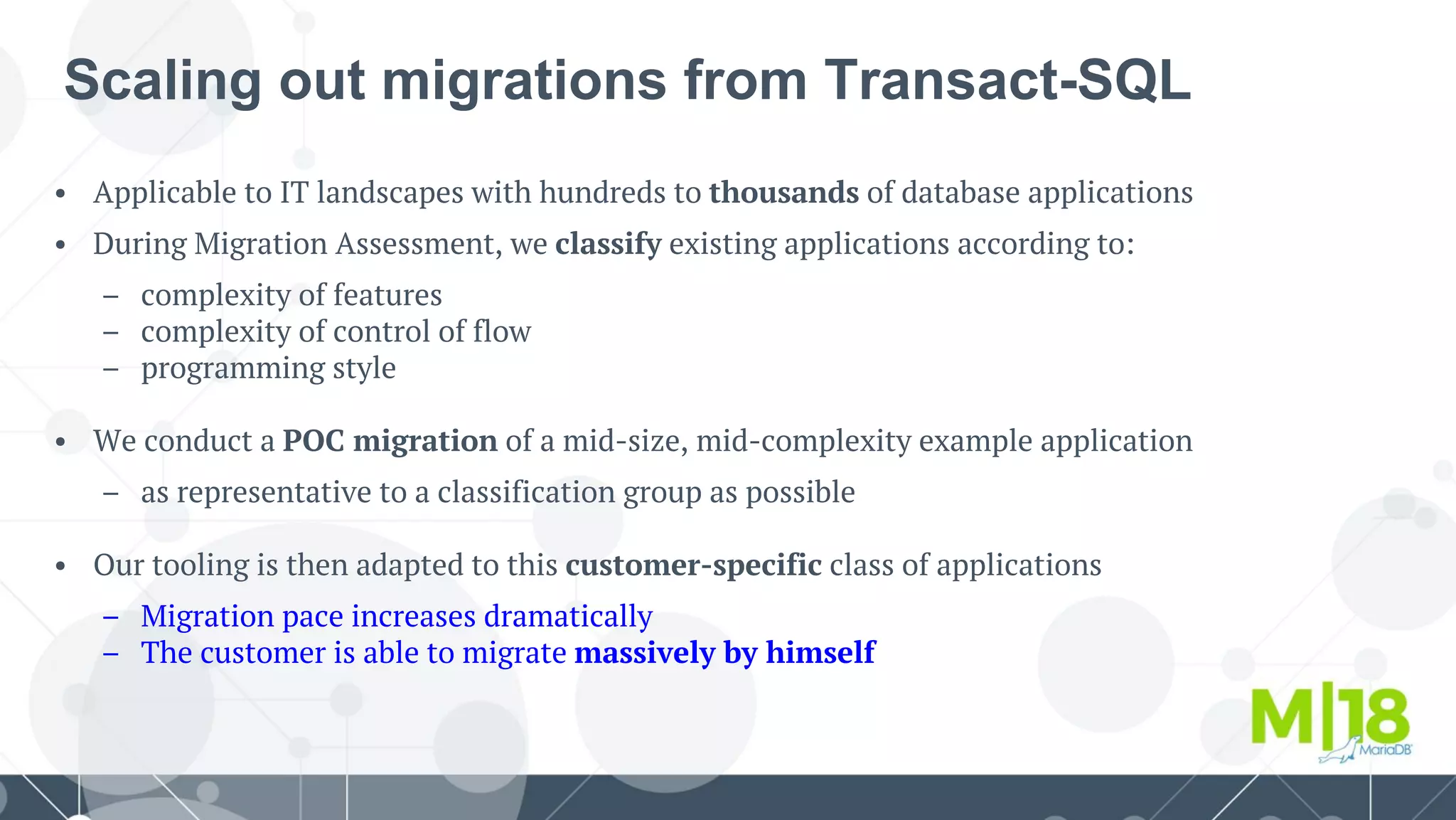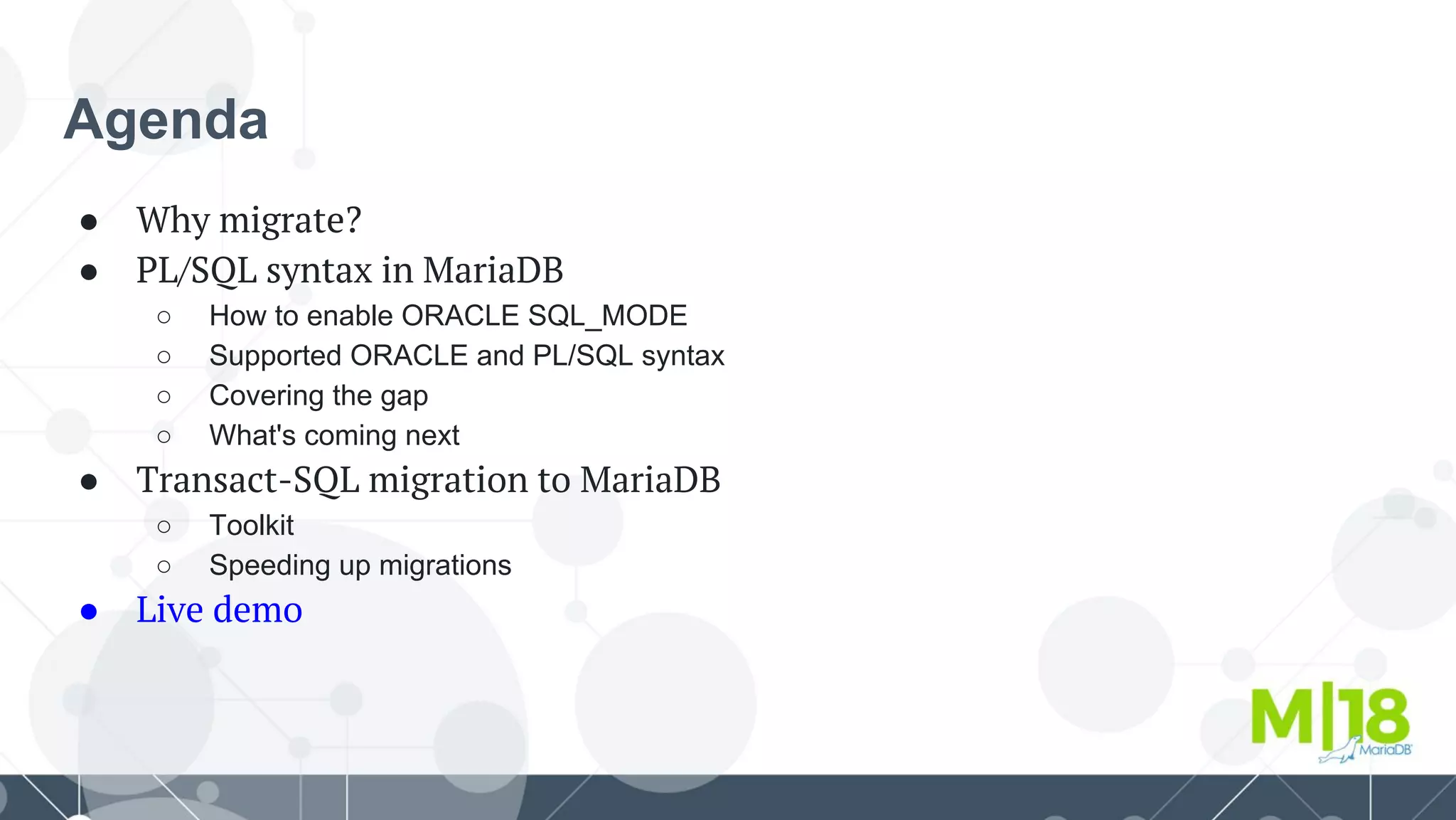The document outlines the improvements in migrating from PL/SQL and Transact-SQL to MariaDB 10.3, emphasizing the ease, speed, and efficiency due to enhanced features and tools. It discusses the support for Oracle SQL syntax, migration processes, and the technological advancements in MariaDB that facilitate these migrations, such as high availability and native PL/SQL parsing. Additionally, it highlights the importance of proper planning, assessment, and execution during the migration process to leverage cost efficiency and compliance.
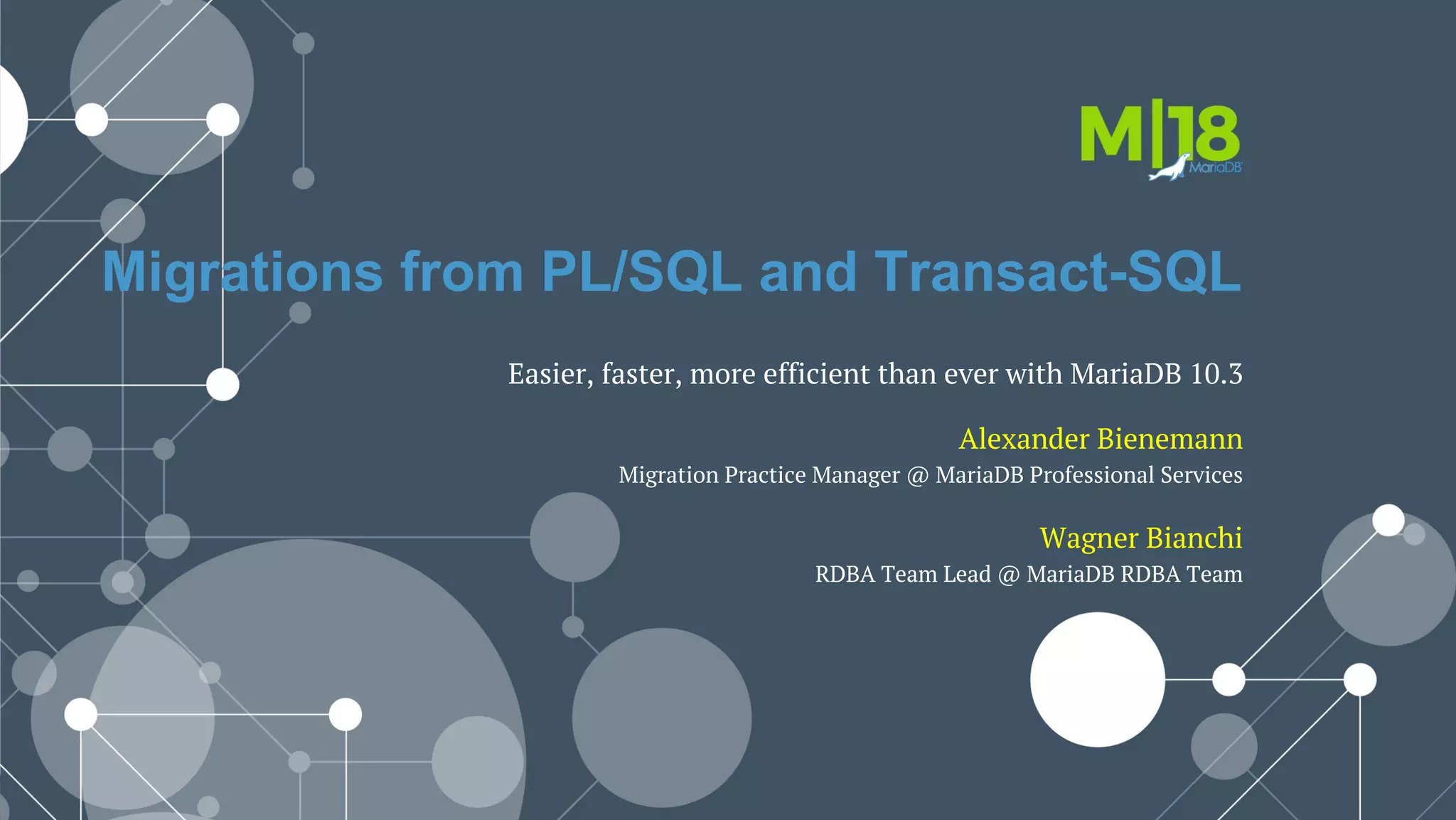
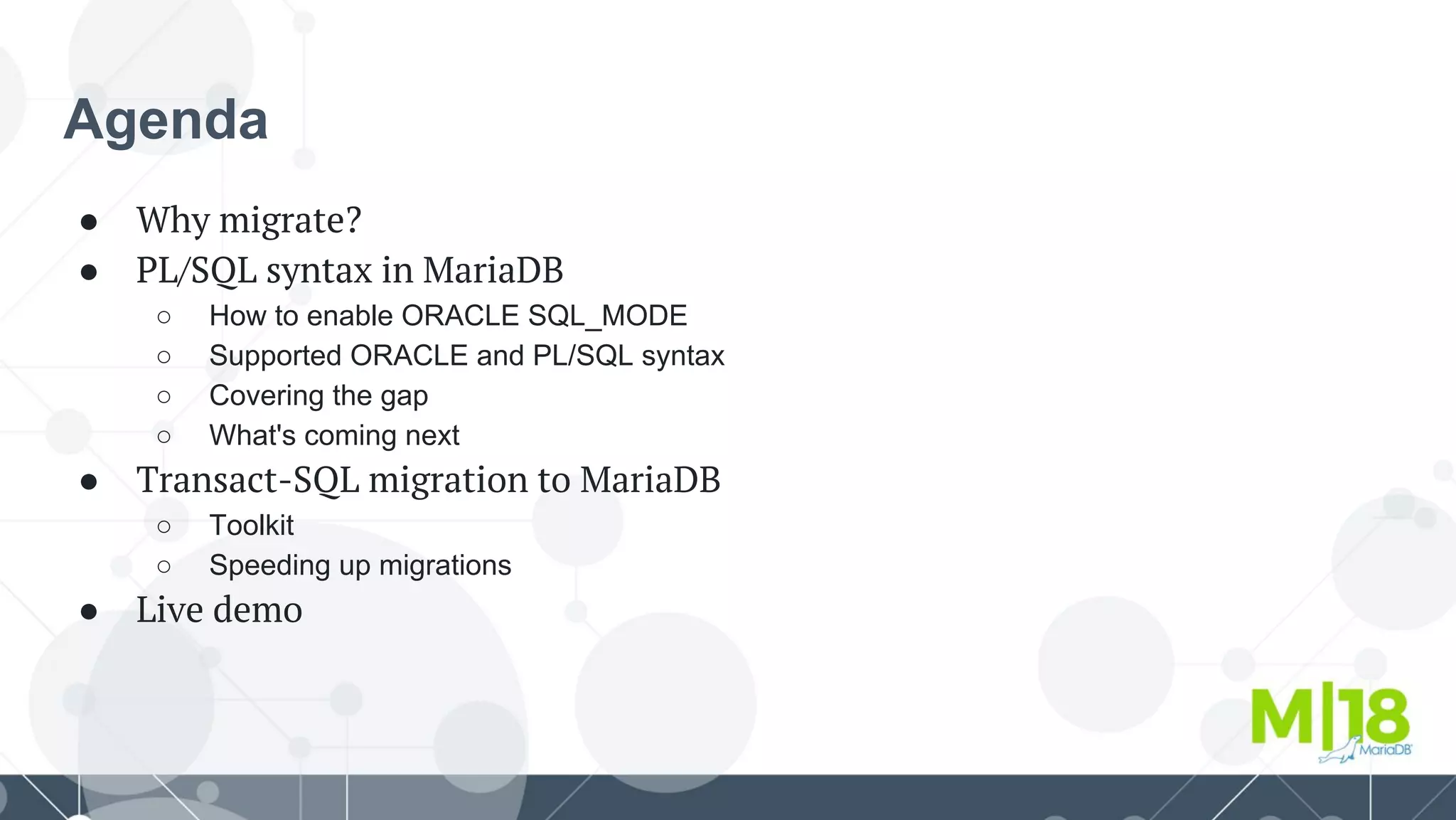
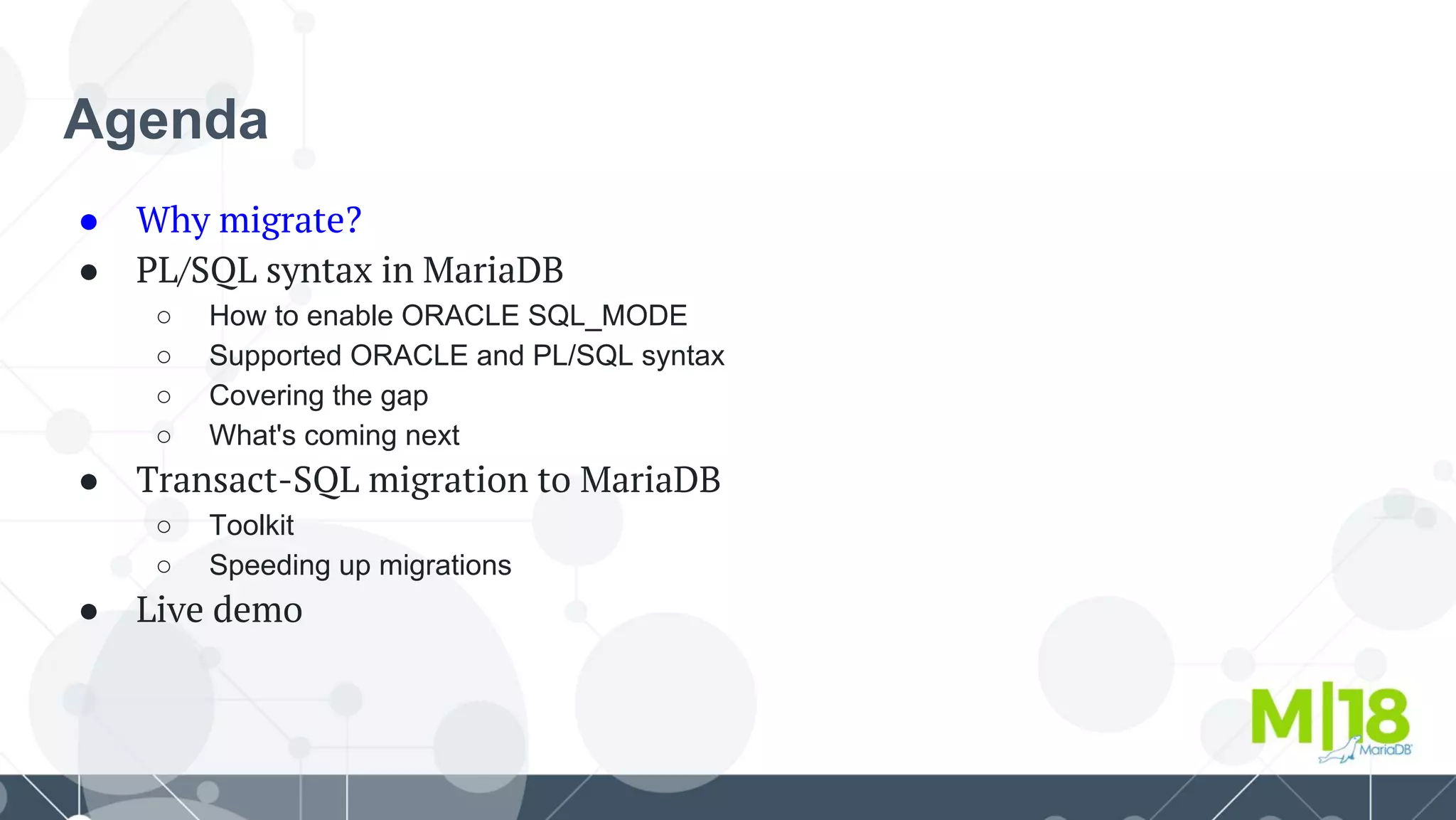

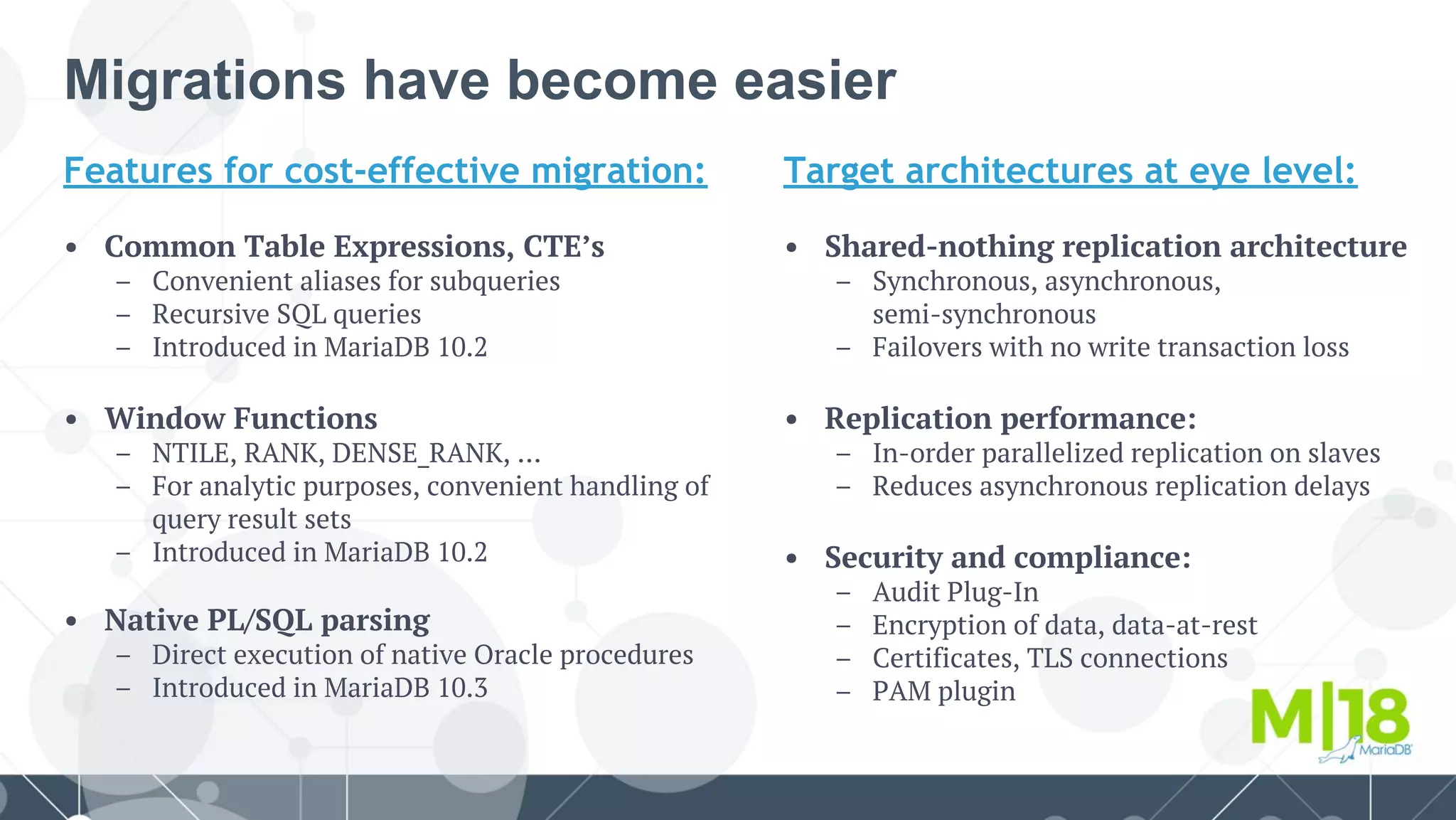
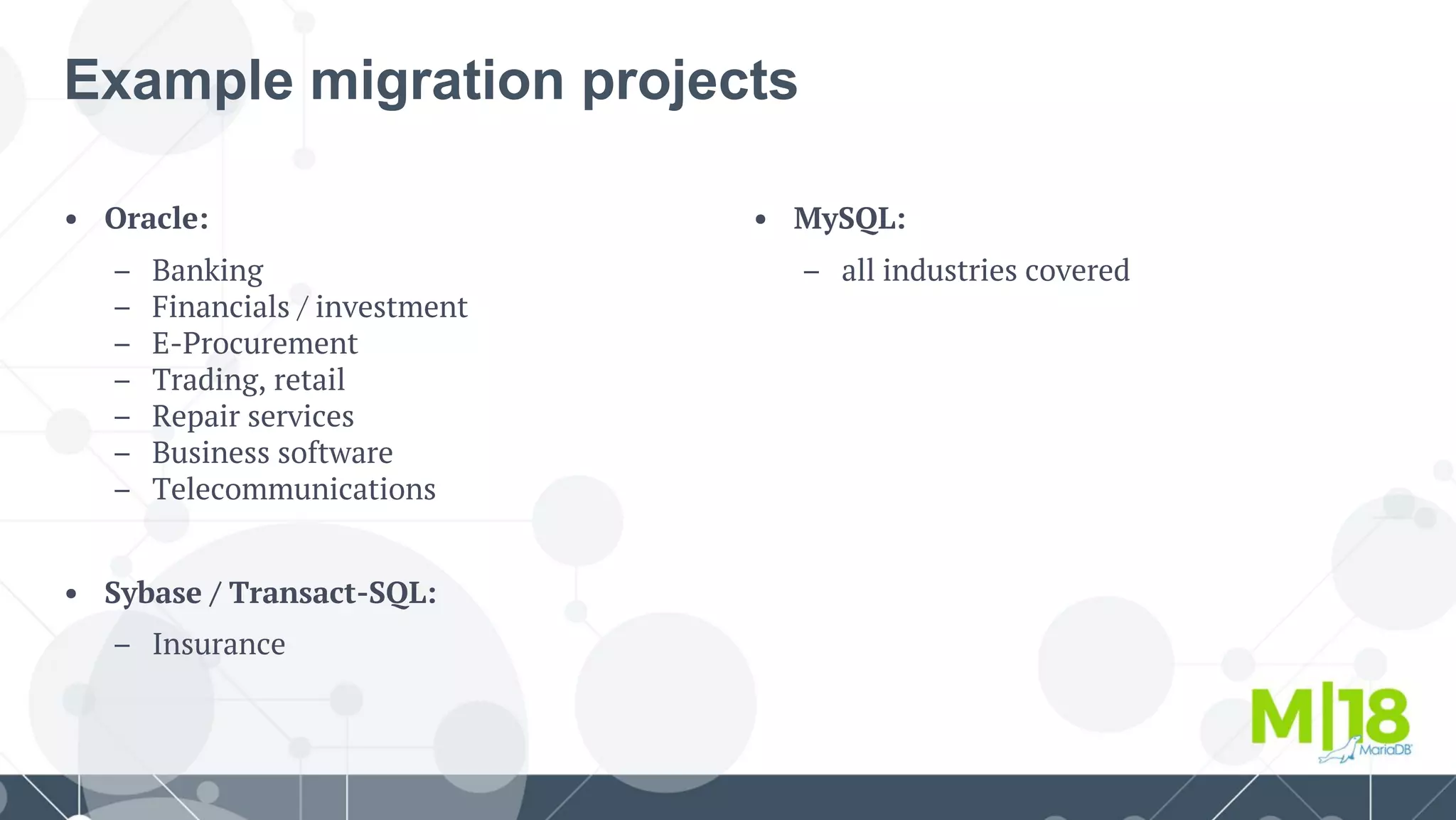
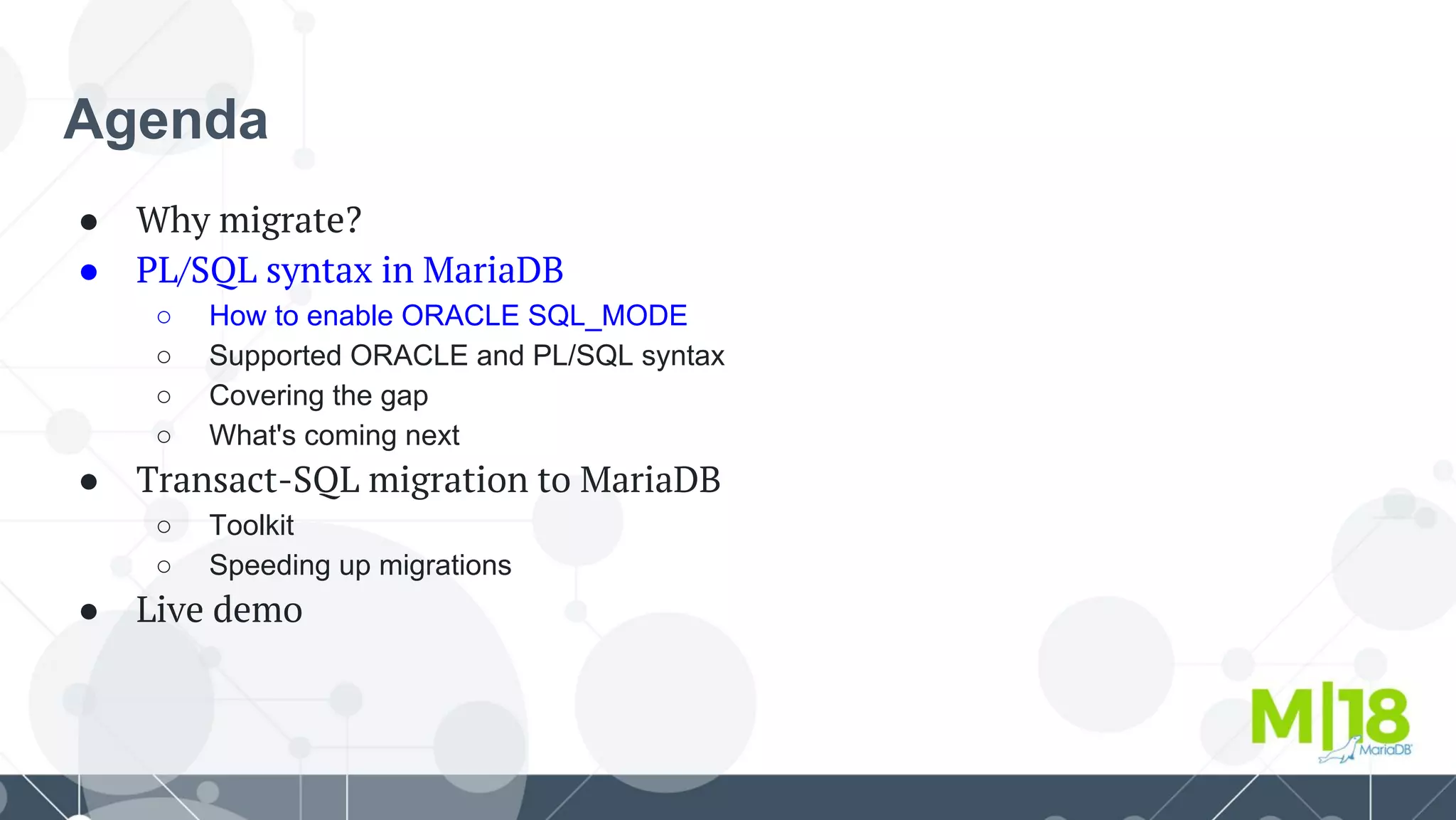
![PL/SQL Syntax in MariaDB
SQL_MODE = ORACLE
● From the version 10.3++, MariaDB starts its support to PL/SQL structures;
● For starting using the new features, everything starts with the SQL_MODE;
○ It can be set on the configuration file and then, restarting the MariaDB Server;
○ One can yet set it dynamically, knowing that this way, the configuration won't survive a restart.
● While running the MariaDB Server with the SQL_MODE as ORACLE:
○ The traditional MariaDB syntax for stored routines won't be available at this point on;
●
●
●
● The best option is to run MariaDB Server with the SQL_MODE set on the
configuration file to avoid losing the feature in case of a restart.
:: wb_on_plsql_mariadb_server :: [(none)]> SELECT @@sql_modeG
*************************** 1. row ***************************
@@sql_mode: PIPES_AS_CONCAT,ANSI_QUOTES,IGNORE_SPACE,ORACLE,NO_KEY_OPTIONS,NO_TABLE_OPTIONS,NO_FIELD_OPTIONS,NO_AUTO_CREATE_USER
1 row in set (0.000 sec)](https://image.slidesharecdn.com/migrationsfromplsqlandtransact-sql-m18-180319161617/75/Migrations-from-PLSQL-and-Transact-SQL-m18-8-2048.jpg)
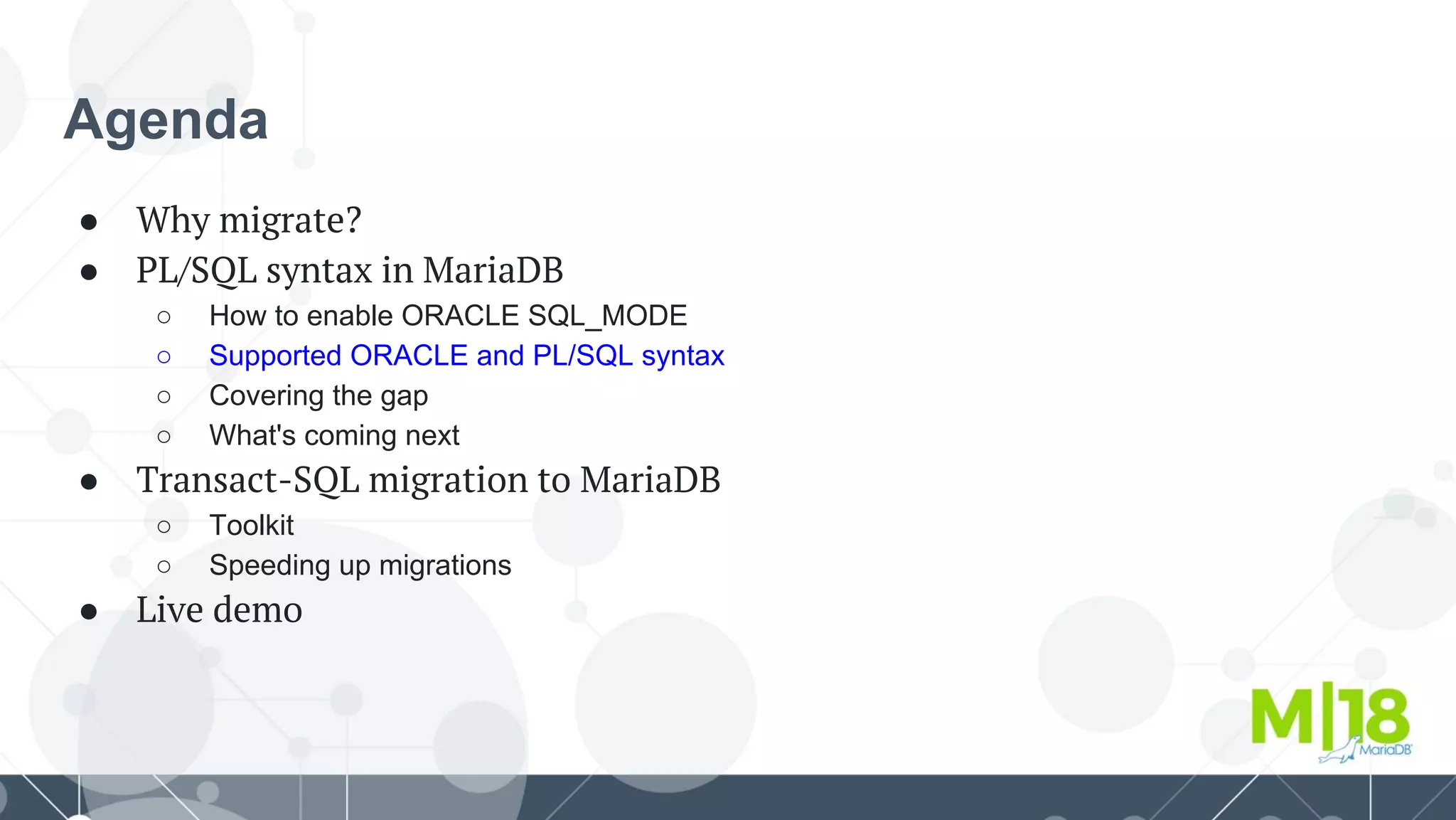
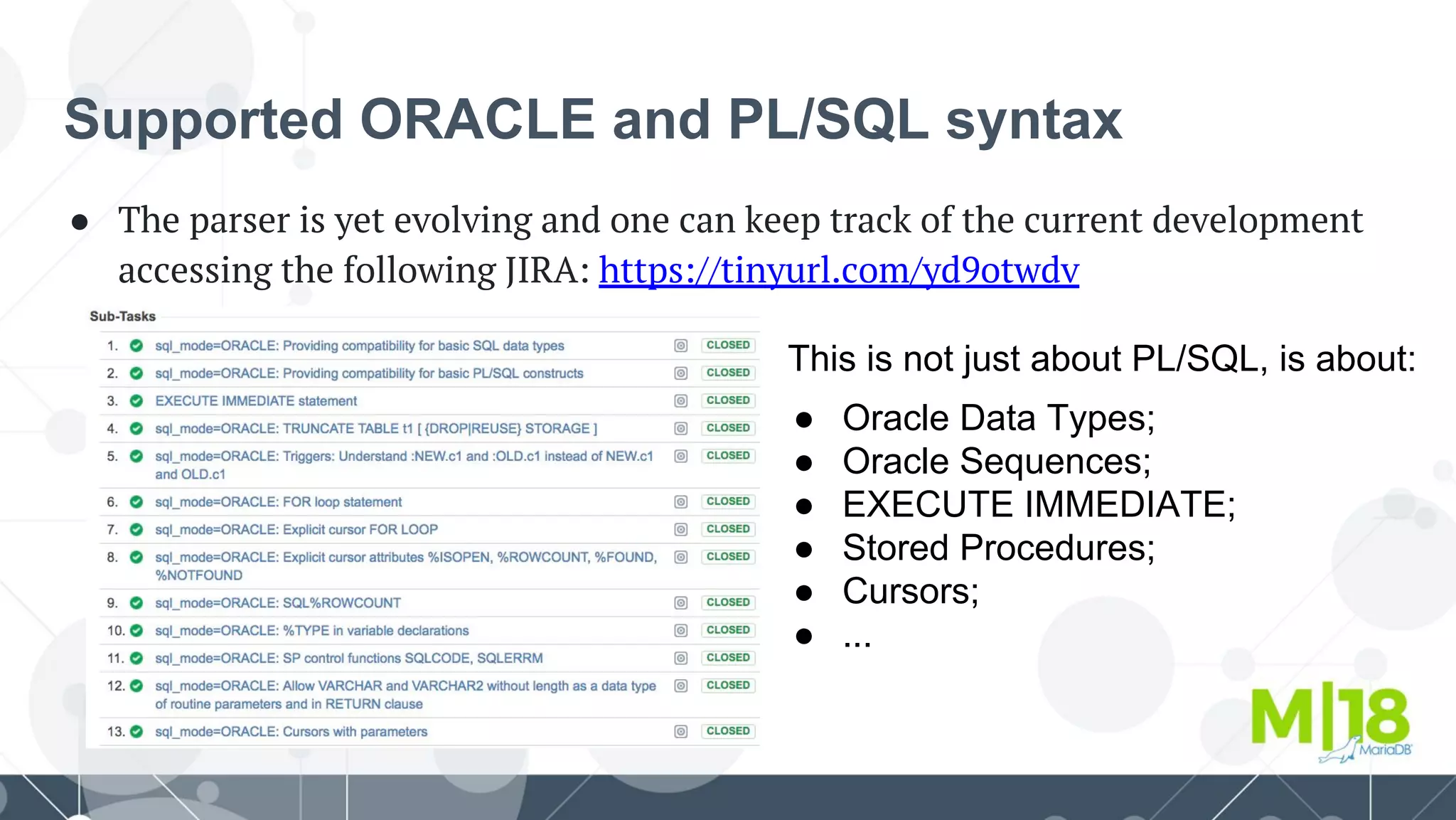
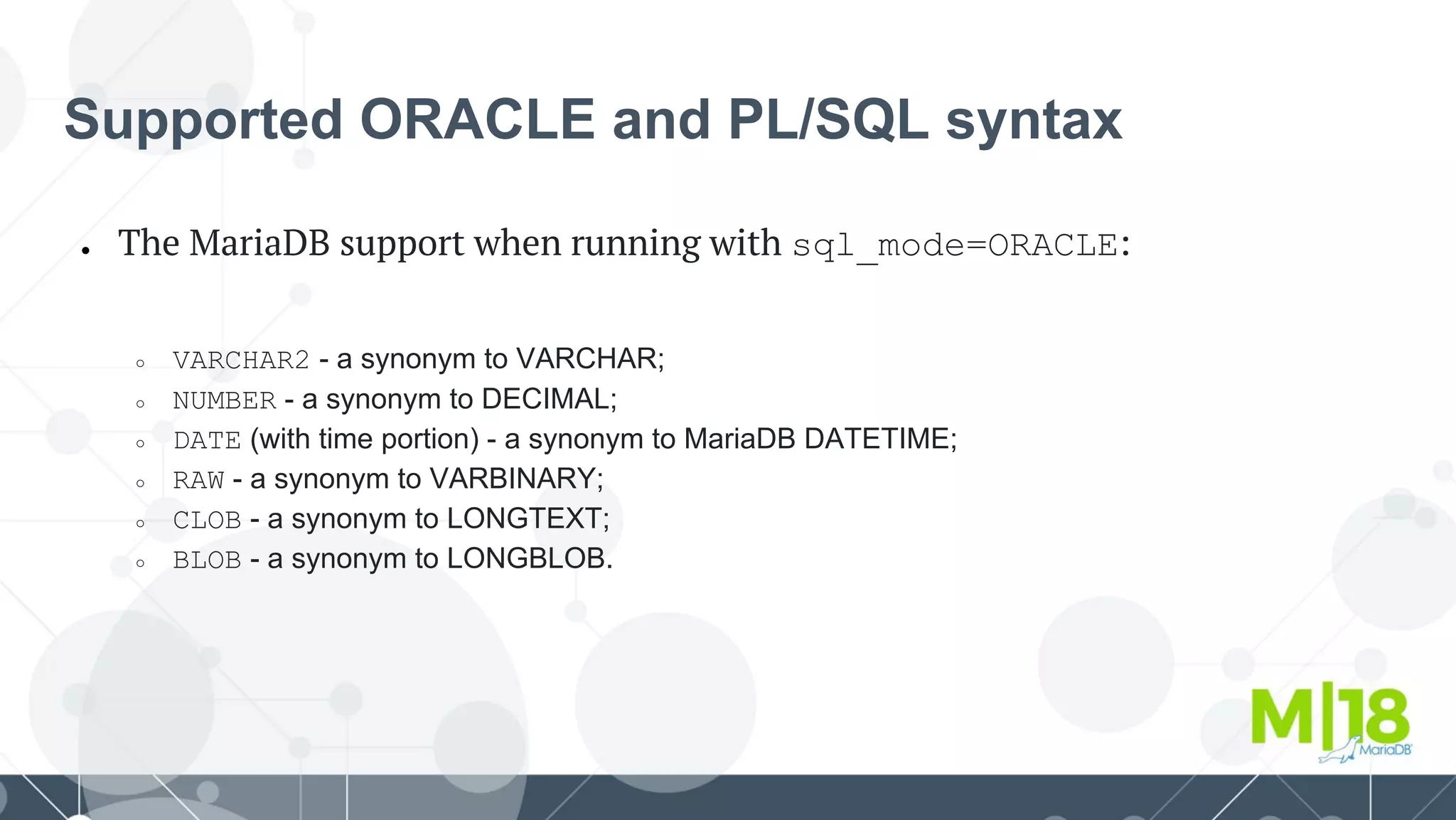
![Supported ORACLE and PL/SQL syntax
● Creating tables with Oracle Data Types:
#: let's create some tables, using ORACLE DATA TYPES
MariaDB [mydb]> CREATE TABLE TBL_CAR_BRAND (
-> CAR_BRAND_NUMBER INTEGER(10) NOT NULL,
-> CAR_BRAND_DESC VARCHAR2(4000) NOT NULL, #: mapped out to MariaDB VARCHAR
-> CAR_BRAND_LOGO BLOB, #: mapped out to MariaDB LONGBLOB
-> PRIMARY KEY(CAR_BRAND_NUMBER)
-> ) ENGINE=InnoDB;
Query OK, 0 rows affected (0.007 sec)
MariaDB [mydb]> CREATE TABLE TBL_CAR (
-> CAR_NUMBER INTEGER(10) NOT NULL,
-> CAR_BRAND_NUMBER INTEGER(10) NOT NULL,
-> CAR_MODEL VARCHAR2(60) NOT NULL,
-> CAR_MODEL_PRICE NUMBER(10,2) NOT NULL, #: mapped out to MariaDB DECIMAL
-> CONSTRAINT FOREIGN KEY (CAR_BRAND_NUMBER) REFERENCES TBL_CAR_BRAND(CAR_BRAND_NUMBER),
-> PRIMARY KEY(CAR_NUMBER)
-> ) ENGINE=InnoDB;
Query OK, 0 rows affected (0.007 sec)](https://image.slidesharecdn.com/migrationsfromplsqlandtransact-sql-m18-180319161617/75/Migrations-from-PLSQL-and-Transact-SQL-m18-12-2048.jpg)
![Supported ORACLE and PL/SQL syntax
● Creating tables with Oracle Data Types:
#: let's create some tables, using ORACLE DATA TYPES
MariaDB [mydb]> CREATE TABLE TBL_CUSTOMER (
-> CUST_NUMBER INTEGER(10) NOT NULL,
-> CUST_NAME VARCHAR2(60) NOT NULL, #: mapped out to MariaDB VARCHAR
-> CUST_DATA_NASC DATE DEFAULT '0000-00-00 00:00:00', #: mapped out to MariaDB DATETIME
-> PRIMARY KEY(CUST_NUMBER)
-> ) ENGINE=InnoDB;
Query OK, 0 rows affected (0.009 sec)
MariaDB [mydb]> CREATE TABLE TBL_RENTAL (
-> RENTAL_NUMBER INTEGER(10) NOT NULL,
-> CAR_NUMBER INTEGER(10) NOT NULL,
-> CUST_NUMBER INTEGER(10) NOT NULL,
-> RENTAL_DT TIMESTAMP DEFAULT CURRENT_TIMESTAMP(),
-> CONSTRAINT FOREIGN KEY (CAR_NUMBER) REFERENCES TBL_CAR(CAR_NUMBER),
-> CONSTRAINT FOREIGN KEY (CUST_NUMBER) REFERENCES TBL_CUSTOMER(CUST_NUMBER),
-> PRIMARY KEY(RENTAL_NUMBER)
-> ) ENGINE=InnoDB;
Query OK, 0 rows affected (0.008 sec)](https://image.slidesharecdn.com/migrationsfromplsqlandtransact-sql-m18-180319161617/75/Migrations-from-PLSQL-and-Transact-SQL-m18-13-2048.jpg)
![Supported ORACLE and PL/SQL syntax
● Creating a SEQUENCE per table of our schema mydb;
#: let's create the SEQUENCEs we're going to attach to tables
MariaDB [mydb]> CREATE SEQUENCE SEQ_CAR MINVALUE 1 START WITH 1 INCREMENT BY 1 CACHE 0;
Query OK, 0 rows affected (0.006 sec)
MariaDB [mydb]> CREATE SEQUENCE SEQ_CUSTOMER MINVALUE 1 START WITH 1 INCREMENT BY 1 CACHE 0;
Query OK, 0 rows affected (0.005 sec)
MariaDB [mydb]> CREATE SEQUENCE SEQ_CAR_BRAND MINVALUE 1 START WITH 1 INCREMENT BY 1 CACHE 0;
Query OK, 0 rows affected (0.005 sec)
MariaDB [mydb]> CREATE SEQUENCE SEQ_RENTAL MINVALUE 1 START WITH 1 INCREMENT BY 1 CACHE 0;
Query OK, 0 rows affected (0.006 sec)](https://image.slidesharecdn.com/migrationsfromplsqlandtransact-sql-m18-180319161617/75/Migrations-from-PLSQL-and-Transact-SQL-m18-14-2048.jpg)
![Supported ORACLE and PL/SQL syntax
● PROCEDURE CREATION: let's create a procedure to add car brands!
MariaDB [mydb]> DELIMITER /
MariaDB [mydb]> CREATE OR REPLACE PROCEDURE mydb.PROC_ADD_CAR_BRAND (
-> p_car_brand_descmydb.TBL_CAR_BRAND.CAR_BRAND_DESC%TYPE,
-> p_car_brand_logomydb.TBL_CAR_BRAND.CAR_BRAND_LOGO%TYPE
-> ) AS
-> BEGIN
-> IF ((p_car_brand_desc <> '') &&(p_car_brand_logo <> '')) THEN
-> -- creating a start savepoint
-> SAVEPOINT startpoint; #: creating an undo point into the local stream
-> -- inserting the new row
-> INSERT INTO TBL_CAR_BRAND(CAR_BRAND_NUMBER,CAR_BRAND_DESC,CAR_BRAND_LOGO)
-> VALUES(SEQ_CAR_BRAND.NEXTVAL,p_car_brand_desc,p_car_brand_logo);
-> ELSE
-> SELECT 'You must provide the cars brand...' AS WARNING;
-> END IF;
-> EXCEPTION
-> WHEN OTHERS THEN
-> -- executing the exception
-> SELECT 'Exception ' || TO_CHAR(SQLCODE)|| ' ' || SQLERRM AS EXCEPTION;
-> -- rolling backup to the savepoint startpoint
-> ROLLBACK TO startpoint;
-> END;
-> /
Query OK, 0 rows affected (0.003 sec)](https://image.slidesharecdn.com/migrationsfromplsqlandtransact-sql-m18-180319161617/75/Migrations-from-PLSQL-and-Transact-SQL-m18-15-2048.jpg)
![Supported ORACLE and PL/SQL syntax
● PROCEDURE CREATION: let's create a procedure to add customers!
MariaDB [mydb]> DELIMITER /
MariaDB [mydb]> CREATE OR REPLACE PROCEDURE mydb.PROC_ADD_CUSTOMER (
-> p_customer_name mydb.TBL_CUSTOMER.CUST_NAME%TYPE,
-> p_customer_data_nasc mydb.TBL_CUSTOMER.CUST_DATA_NASC%TYPE
-> ) AS
-> BEGIN
-> IF ((p_customer_name <> '') &&(p_customer_data_nasc <> '0000-00-00 00:00:00')) THEN
-> -- creating a start savepoint
-> SAVEPOINT startpoint;
-> -- inserting the new row
-> INSERT INTO TBL_CUSTOMER(CUST_NUMBER,CUST_NAME,CUST_DATA_NASC)
-> VALUES(SEQ_CUSTOMER.NEXTVAL,p_customer_name,p_customer_data_nasc);
-> ELSE
-> SELECT 'You must provide the customers information...' AS WARNING;
-> END IF;
-> EXCEPTION
-> WHEN OTHERS THEN
-> -- executing the exception
-> SELECT 'Exception ' || SQLCODE || ' ' ||SQLERRM AS EXCEPTION;
-> -- rolling backup to the savepoint startpoint
-> ROLLBACK TO startpoint;
-> END;
-> /
Query OK, 0 rows affected (0.003 sec)](https://image.slidesharecdn.com/migrationsfromplsqlandtransact-sql-m18-180319161617/75/Migrations-from-PLSQL-and-Transact-SQL-m18-16-2048.jpg)
![Supported ORACLE and PL/SQL syntax
● PROCEDURE CALLS: let's add data to our database schema!
#: car brands
MariaDB [mydb]> CALL mydb.PROC_ADD_CAR_BRAND('Audi',md5('logo.') || '.jpg')/
Query OK, 1 row affected (0.004 sec)
MariaDB [mydb]> SELECT * FROM TBL_CAR_BRAND/
+------------------+----------------+--------------------------------------+
| CAR_BRAND_NUMBER | CAR_BRAND_DESC | CAR_BRAND_LOGO |
+------------------+----------------+--------------------------------------+
| 1 | Ferrari | 1f98cd1e57fbf3714f058ccf10fc9e9a.jpg |
| 2 | Audi | 1f98cd1e57fbf3714f058ccf10fc9e9a.jpg |
+------------------+----------------+--------------------------------------+
2 rows in set (0.000 sec)
#: customers
MariaDB [mydb]> CALL mydb.PROC_ADD_CUSTOMER('Bianchi','1980-01-01 10:30:00')/
Query OK, 1 row affected (0.005 sec)
MariaDB [mydb]> SELECT * FROM TBL_CUSTOMER/
+-------------+-----------------+---------------------+
| CUST_NUMBER | CUST_NAME | CUST_DATA_NASC |
+-------------+-----------------+---------------------+
| 1 | Bianchi, Wagner | 1980-01-01 10:30:00 |
+-------------+-----------------+---------------------+
1 row in set (0.000 sec)](https://image.slidesharecdn.com/migrationsfromplsqlandtransact-sql-m18-180319161617/75/Migrations-from-PLSQL-and-Transact-SQL-m18-17-2048.jpg)


